1. Introduction: to Detroit Diesel Engines
– History, development, and applications of Detroit Diesel engines
Below is a great video posted on Youtube by “Dust Runners Automotive Journal” on the history of Detroit Diesel engines.
– Overview of different engine series and models
Series 53 Engines
The Series 53 engine by Detroit Diesel is a notable engine series with a rich history. Here’s a brief overview of its development and evolution:
- Development: The Series 53 engine was introduced by Detroit Diesel Corporation in 1957. It was designed as a smaller, lightweight, two-stroke engine for various applications, including trucks, buses, construction equipment, and marine vessels. The engine was named “53” to reflect its cylinder displacement of 53 cubic inches per cylinder.
- Initial Models: The initial models in the Series 53 engine lineup was the 3-53 engines. The numbers indicated the number of cylinders in each engine. The 3-53 had three cylinders. These engines were known for their compact size and relatively high power output, making them popular choices for smaller vehicles and equipment.
- Expansion: Over the years, Detroit Diesel expanded the Series 53 engine lineup to include additional models. This included the introduction of the 4-53, 6V-53, and 8V-53 engines. The number before the cylinder count indicated the number of cylinders arranged in a “V” configuration. For example, the 6V-53 had six cylinders arranged in a V shape.
- Features and Advantages: The Series 53 engines were known for their robust construction, simplicity, and durability. They utilized a two-stroke cycle, which offered a good power-to-weight ratio and high torque output. They were also designed to be reliable and easy to maintain, making them popular choices for various applications in the transportation and industrial sectors.
- Popularity and Legacy: The Series 53 engines gained significant popularity and were widely used in a range of applications. They were especially favored in the trucking industry, where they powered many medium-duty and heavy-duty trucks. These engines were recognized for their distinctive sound, earning them the nickname “Screaming Jimmy” due to the high-pitched whine produced by their superchargers.
- Discontinuation: As emission regulations became stricter in the 1990s, the Series 53 engine could no longer meet these requirements. Detroit Diesel phased out the Series 53 engine series and replaced it with more advanced and environmentally compliant engine models.
While the Series 53 engine series is no longer in production, it remains a notable part of Detroit Diesel’s history and there are still many in use today in many applications including marine. .
Series 71 Engines
The Series 71 engine by Detroit Diesel is an iconic and historically significant engine series. Here is a comprehensive history of its development and evolution:
- Introduction: The Series 71 engine was first introduced by Detroit Diesel Corporation in 1938. It was initially designed as a two-stroke, inline engine for use in heavy-duty applications such as trucks, buses, and industrial machinery. The name “71” was derived from the engine’s per-cylinder displacement of 71 cubic inches.
- Early Models: The initial Series 71 engine models were the 6-71 and 4-71. These designations indicated the number of cylinders in each engine. The 6-71 had six cylinders, while the 4-71 had 4 cylinders. These engines quickly gained popularity due to their robust design, high power output, and excellent torque characteristics.
- WWII and Post-War Era: During World War II, the Series 71 engines played a crucial role in powering military vehicles, tanks, and generators. After the war, Detroit Diesel adapted the Series 71 for civilian use, and it became widely recognized for its durability and reliability.
- Expansion and Variants: Over time, Detroit Diesel expanded the Series 71 engine lineup to include various models and configurations. This included the introduction of V-configured engines, such as the 6V-71 and 8V-71, which featured six and eight cylinders respectively arranged in a “V” shape. Additionally, larger displacement models were developed, including the 12V-71 and 16V-71, which further increased power output for heavy-duty applications.
- Applications and Popularity: The Series 71 engines gained immense popularity and were extensively used in a wide range of applications. They powered trucks, buses, construction equipment, boats, military vehicles, and even locomotives. Their versatility, reliability, and power made them a preferred choice for many industries worldwide.
- Notable Features: The Series 71 engines were known for their distinctive sound, often described as a throaty rumble. They utilized a two-stroke cycle, where power was generated on both the upstroke and downstroke of the pistons, providing a high power-to-weight ratio. These engines were also notable for their straightforward design, easy maintenance, and adaptability to various fuel types.
- Legacy: The Series 71 engine became an enduring icon of the diesel engine industry. It found a place in popular culture and was celebrated for its reputation as a workhorse engine. Numerous television shows, movies, and songs featured references to the Series 71. Its popularity continued well into the 20th century.
- Phasedown and Transition: As emission regulations became more stringent in the 1980s and 1990s, Detroit Diesel phased out the Series 71 engine series. It was replaced by newer engine designs that complied with environmental standards, such as the Series 92 and Series 60 engines.
Despite its discontinuation, the Series 71 engine is still used by many boats for power and generation systems as they have been rebuilt and maintained.
92 Series Engines
The Series 92 engine by Detroit Diesel is a significant engine series known for its power and durability. Here’s a history of its development and evolution:
- Introduction: The Series 92 engine was introduced by Detroit Diesel Corporation in 1973. It was designed as a heavy-duty, two-stroke, V-block engine primarily intended for use in trucks and buses. The engine series was named “92” to reflect its per-cylinder displacement of 92 cubic inches.
- Models and Configurations: The Series 92 engine initially included the 6V-92 and 8V-92 models, denoting the number of cylinders arranged in a V configuration. The 6V-92 had six cylinders, while the 8V-92 had eight. Over time, Detroit Diesel expanded the lineup to include more variants, such as the 16V-92 with 16 cylinders.
- Advanced Design: The Series 92 engine incorporated several advanced features and technologies. It utilized a two-stroke cycle with supercharging and turbocharging, resulting in high power output and torque. The engine had a high compression ratio, direct fuel injection, and a cross-flow cylinder head design, which improved efficiency and performance.
- Applications and Popularity: The Series 92 engine quickly gained popularity and found widespread use in heavy-duty applications. It powered a variety of vehicles and equipment, including trucks, buses, construction machinery, power generators, and marine vessels. The engine’s exceptional power-to-weight ratio and robust construction made it suitable for demanding tasks in various industries.
- Evolution and Enhancements: Detroit Diesel continuously enhanced the Series 92 engine to improve performance and meet changing emissions regulations. They introduced the Turbocharged Intercooled (TI) versions, which further increased power and efficiency. Later advancements included electronic controls and fuel systems to enhance engine management and optimize fuel consumption.
- Legacy: The Series 92 engine left a significant impact on the diesel engine industry. It became known for its impressive power output, durability, and ability to handle heavy loads. The distinctive sound of the engine, characterized by a deep rumble, further contributed to its popularity.
- Transition to the Series 60: As emissions standards became more stringent in the 1990s and 2000s, Detroit Diesel phased out the Series 92 engine. It was replaced by the Series 60 engine, which featured advanced electronic controls and met the new emission requirements while maintaining high performance.
- Aftermarket and Remanufacturing: Although the Series 92 engine is no longer in production, there is still an active aftermarket and remanufacturing support for these engines. Many companies specialize in rebuilding and restoring Series 92 engines, allowing owners to keep them in operation or restore vintage vehicles and boats. its legacy lives on through the remanufactured engines still in use and the impact it made on the industry.
Series 60 Engines
The Series 60 engine by Detroit Diesel is a highly successful and influential engine series known for its advanced technology and reliability. Here is a history of its development and evolution:
- Introduction: The Series 60 engine was introduced by Detroit Diesel Corporation in 1987. It was designed as a heavy-duty, four-stroke, inline six-cylinder engine. The engine was developed to meet the increasingly stringent emission regulations while offering improved fuel efficiency and performance.
- Electronic Controls: The Series 60 engine was one of the first commercial diesel engines to incorporate electronic controls. Electronic engine controls allowed for precise fuel injection timing and improved combustion, resulting in better fuel economy and reduced emissions. The electronic controls also facilitated engine diagnostics and monitoring.
- Turbocharged and Intercooled: The Series 60 engine featured a turbocharged and intercooled design. The turbocharger increased the engine’s power output by forcing more air into the cylinders, while the intercooler cooled the compressed air before it entered the engine, improving combustion efficiency and performance.
- Continuous Improvements: Over the years, Detroit Diesel continuously improved the Series 60 engine to enhance its performance, reliability, and durability. The engine underwent several design updates and advancements in electronic controls, fuel systems, and turbocharging technology. These updates resulted in increased power, reduced emissions, and improved overall efficiency.
- Applications and Popularity: The Series 60 engine quickly gained popularity and became a preferred choice for various heavy-duty applications. It powered a wide range of vehicles, including trucks, buses, construction equipment, and power generators. The engine’s reliability, fuel efficiency, and smooth operation contributed to its widespread adoption across different industries.
- Emissions Compliance: The Series 60 engine played a crucial role in helping vehicle manufacturers meet increasingly stringent emission regulations. It incorporated advanced emission control technologies, such as exhaust gas recirculation (EGR), to reduce nitrogen oxide (NOx) emissions. Later versions of the engine also incorporated diesel particulate filters (DPF) and selective catalytic reduction (SCR) systems to further reduce emissions.
- Legacy and Production: The Series 60 engine’s success led to its production for over two decades. It became one of the most successful and widely used heavy-duty diesel engines in the industry. The engine’s reputation for durability, performance, and emissions compliance solidified its position as a benchmark for modern diesel engines.
- Phasedown and Transition: With the introduction of stricter emission regulations and the advancement of engine technology, Detroit Diesel phased out the Series 60 engine in 2010. It was replaced by the Detroit DD13, DD15, and DD16 engine series, which incorporated even more advanced technologies to meet the evolving emissions standards.
The Series 60 engine by Detroit Diesel revolutionized the heavy-duty diesel engine market with its electronic controls, advanced turbocharging, and compliance with emission regulations. Its longevity, reliability, and widespread use have left an indelible mark on the industry, and its legacy continues through the advancements made in modern diesel engine technology.
Series 149 Engines
These are larger engines in the Detroit Diesel lineup. We service the following engines:
The 8.2L Engine
The 8.2L engine by Detroit Diesel is a notable engine that was produced for several years. Here’s a history of its development and evolution:
- Introduction: The 8.2L engine, also known as the Detroit Diesel Fuel Pincher, was introduced by General Motors in the 1980s. It was designed as a medium-duty, V8, four-stroke engine primarily used in trucks, buses, and industrial applications.
- Fuel Pincher Technology: The 8.2L engine was known for its unique “Fuel Pincher” technology. This technology involved the use of a pre-combustion chamber where a small amount of fuel was injected. The fuel-air mixture in the pre-chamber would then ignite and rapidly spread into the main combustion chamber, resulting in improved fuel efficiency and reduced emissions.
- Variants and Applications: The 8.2L engine was available in various configurations to suit different applications. It was offered in naturally aspirated (non-turbocharged) and turbocharged versions, providing different power outputs and torque characteristics. The engine found use in a range of vehicles, including medium-duty trucks, buses, motorhomes, and some agricultural and construction equipment.
- Popularity and Issues: The 8.2L engine gained popularity due to its fuel efficiency and reasonable power output. However, it faced some challenges during its production. Issues such as cylinder head gasket failures and cracked cylinder heads were reported, which affected engine reliability. These problems led to a decline in the engine’s reputation and eventual discontinuation.
- Discontinuation: Production of the 8.2L engine was discontinued in the late 1990s. The discontinuation was influenced by several factors, including the introduction of stricter emissions regulations and the engine’s reliability concerns. It was replaced by newer engine models that met the evolving emission standards and offered improved performance.
While the 8.2L engine had its challenges, it still played a role in the diesel engine market during its production years. It offered a unique fuel-saving technology and found use in various applications. However, it is important to note that the engine’s reliability issues led to its eventual discontinuation.
2. Engine Components and Systems
– Detailed study of major engine components and systems
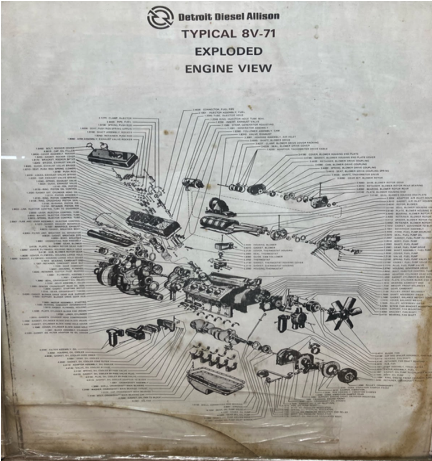
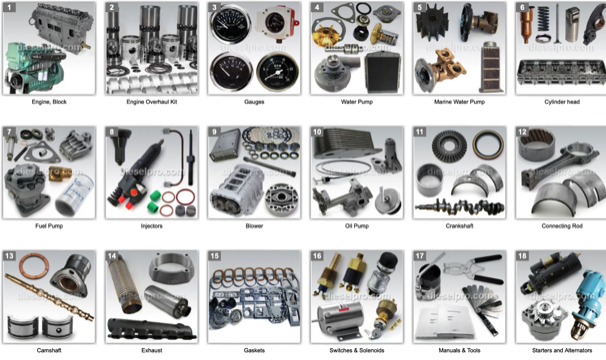
Selection of parts:
Some engines have 2 valve heads, some have 4 valve heads, and some are turbo within the same model of engine. The parts for engines with these types of differing components may be different so they are separated into separate sections.
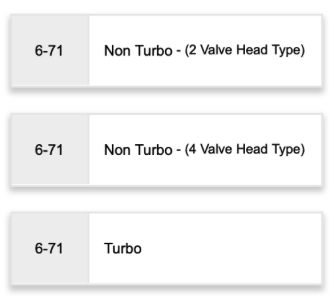
Below is a 2 valve head meaning that there are two valves for every cylinder.
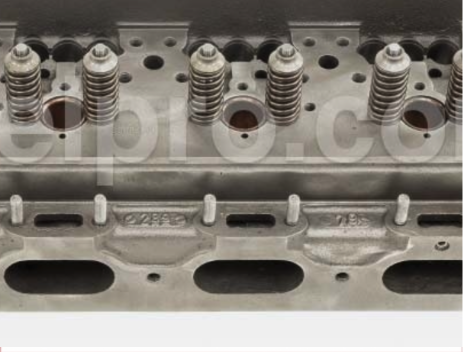
Below is a 4 valve head meaning that there are 4 valves for every cylinder.
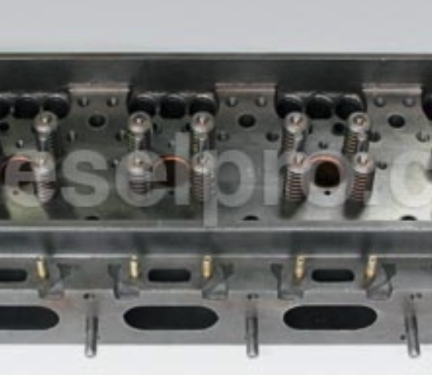
Below is a turbo, turbos add extra air to the combustion chamber and give the engine extra power. The components of the engine are different to handle this extra power.
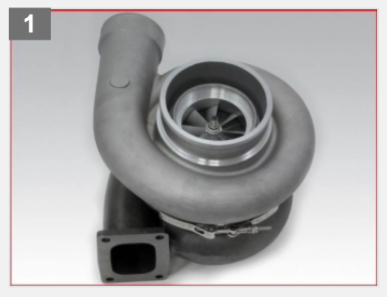
Engine Block
The engine block section contains long blocks, blocks, and major engine components like the gears that are part of the block.
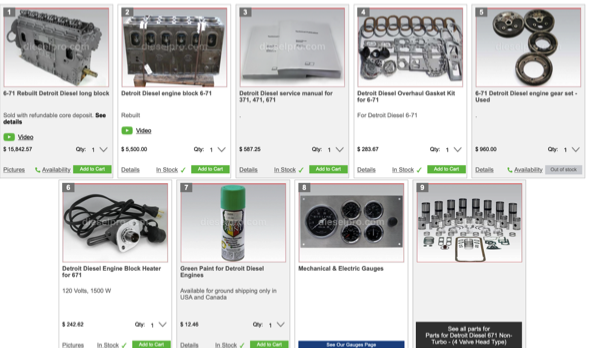
Engine Overhaul Kits
This section has the overhaul kits, “rebuild kits”, or “ inframe kits”. Tools for doing this type of overhaul and liner inserts and shims. Notable tools are the cylinder liner puller which is used to pull cylinder liners out of the engine block, and the piston rings compressor which is used to put the piston into the liner.
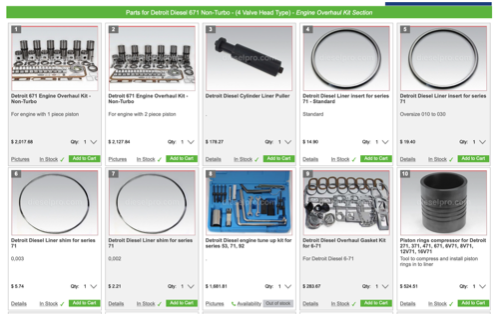
Crankshaft Section
The crankshaft in Detroit Diesel 2-stroke engines is a vital component responsible for converting the reciprocating motion of the pistons into rotational motion. It is connected to the pistons through connecting rods and transfers the power generated during combustion to the engine’s drivetrain. The crankshaft’s design and construction are robust to withstand the high pressures and forces generated in the combustion process. It plays a crucial role in the engine’s smooth operation, power delivery, and overall reliability in 2-stroke applications.
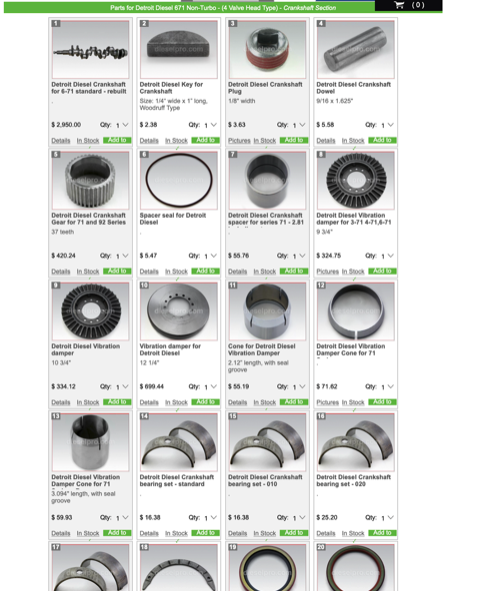
Camshaft Section
The camshaft for Detroit Diesel engines is a vital component that controls the opening and closing of the engine’s valves. It is a cylindrical shaft with lobes or cams strategically positioned along its length. As the camshaft rotates, these lobes press against the valve lifters, causing the valves to open and close at precise intervals. This synchronizes the intake and exhaust processes, enabling efficient fuel combustion and power generation. The camshaft’s design and timing play a crucial role in optimizing engine performance, fuel economy, and overall reliability.
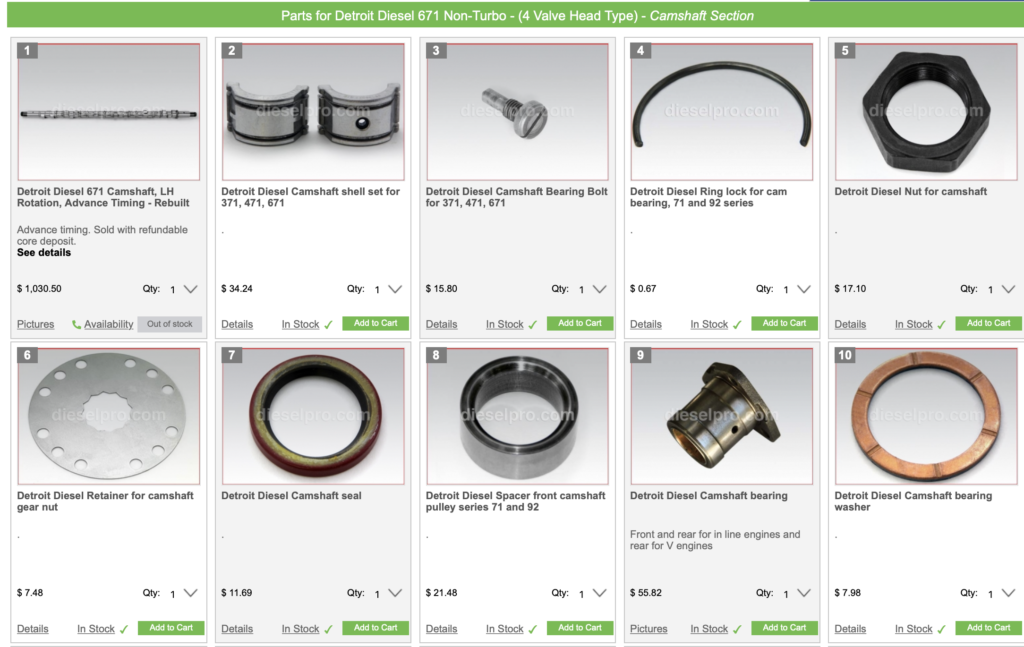
Connecting Rod Section
The connecting rods in Detroit Diesel engines are crucial components that connect the pistons to the crankshaft. They are sturdy metal rods with a split design, allowing them to fit around the crankshaft journal and attach to the piston pin. Connecting rods transmit the reciprocating motion of the pistons to the rotational motion of the crankshaft, converting linear motion into rotational energy. They must be robust to withstand high combustion forces and provide reliable power transfer, contributing to the engine’s durability and overall performance.
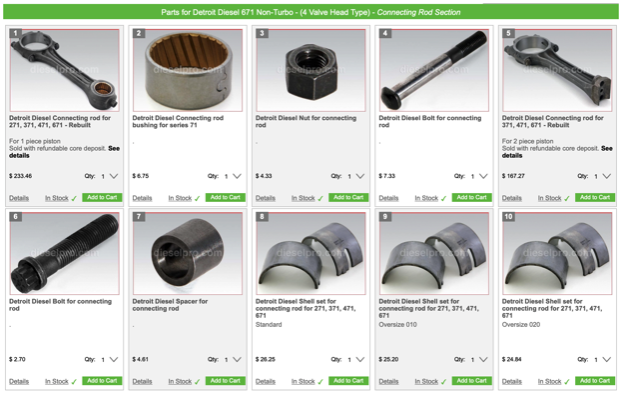
Exhaust Manifold Section
The exhaust manifolds in Detroit Diesel engines are integral components that collect and channel exhaust gases away from the engine cylinders. They are typically made of durable cast iron and are designed to withstand high temperatures and pressures. The manifolds collect exhaust gases from each cylinder and direct them into a single outlet, which leads to the exhaust system. The design of the exhaust manifolds ensures efficient flow of exhaust gases, helps reduce backpressure, and contributes to overall engine performance and emissions control.

Cylinder Head Section
The cylinder head in a Detroit Diesel engine is responsible for crucial functions. It encloses the combustion chamber, seals the cylinders to maintain compression, houses the intake and exhaust valves for proper air flow, and provides cooling passages to manage engine temperature. It also incorporates fuel injection ports or injectors to deliver fuel into the combustion chamber. Additionally, the cylinder head acts as a mounting surface for various engine components. Overall, the cylinder head plays a vital role in sealing, valve operation, cooling, fuel injection, and integration of engine systems, contributing to the engine’s performance and reliability.

Ways that we sell cylinder heads:
- Bare Cylinder Head
This cylinder head comes bare (without valves and springs installed).

- With Springs & Valves
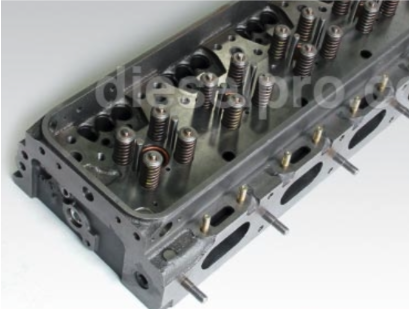
- Complete Cylinder Head:
- Valves ( J 6 )
- • Springs
- • Rocker arms
- • Push rods
- • Cam followers
- • Valve bridges
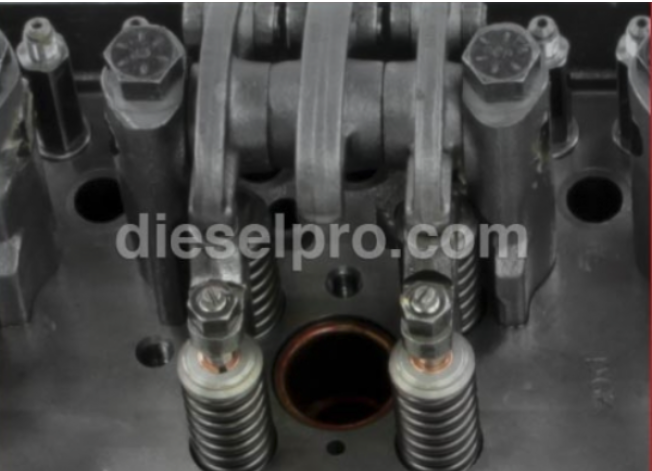
Blower Section
The blower in Detroit Diesel 2-stroke engines serves the crucial role of scavenging the combustion chambers. As a two-stroke engine does not have separate intake and exhaust strokes, the blower provides a continuous flow of air, pushing out exhaust gases and drawing in fresh air for combustion. This scavenging process is vital for efficient operation and power generation in 2-stroke engines. The blower ensures proper air circulation and aids in maintaining the engine’s performance and reliability.
Blowers for inline engines can be either right hand or left hand. Use this guide to help you determine which one is needed.
The blower section includes all of the components for the blower including blower repair kits, blower installation kits, blower couplings, blower shafts and more.

Turbocharger Section
The turbocharger for Detroit Diesel engines is a forced induction device that increases the engine’s power and efficiency by compressing incoming air. It consists of a turbine and a compressor mounted on the same shaft. Exhaust gases drive the turbine, which powers the compressor to compress the intake air. This increases air density, allowing more fuel to be burned, resulting in improved engine performance and fuel economy.

– Understanding the fuel system, cooling system, lubrication system, and electrical system
Fuel System Sections
On Dieselpro.com the fuel system is broken down into two parts.
- The Fuel Pump Section
The fuel pump for Detroit Diesel engines is a vital component responsible for delivering fuel to the engine’s combustion chambers. It operates using a mechanical design, utilizing a camshaft-driven plunger system. The pump draws fuel from the fuel tank and pressurizes it to the required level before delivering it to the fuel injectors. This ensures optimal fuel atomization and distribution, promoting efficient combustion and engine performance. The fuel pump’s reliability and precision are crucial for the smooth operation of Detroit Diesel engines in various applications.

- The Injector Section
Mechanical injectors for Detroit Diesel engines are crucial components responsible for delivering precise amounts of fuel into the engine’s combustion chambers. These injectors operate mechanically, utilizing a camshaft-driven plunger system. When the fuel pressure reaches a certain threshold, the injectors open, allowing fuel to be injected into the cylinders. This precise fuel delivery ensures optimal combustion, engine power, and efficiency. Mechanical injectors are known for their durability and reliability, making them a preferred choice for Detroit Diesel engines in various applications.
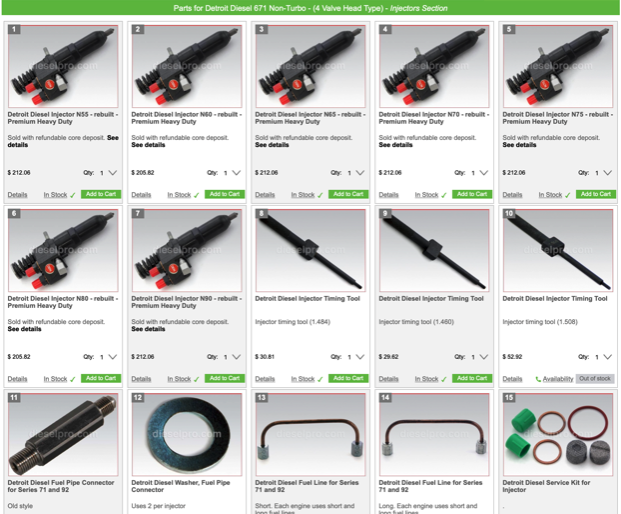
Cooling System Sections
On dieselpro.com the cooling system is broken down into two parts. The freshwater (or coolant) pump section, and the raw water pump section.
- Freshwater Pump Section
The freshwater pump for Detroit Diesel engines is a key component that circulates coolant or fresh water to maintain optimal engine temperature and prevent overheating. It operates using a mechanical or electric design, drawing water from a reservoir or the engine’s cooling system and circulating it through the engine block and radiator. The pump’s impeller creates the necessary pressure to ensure proper coolant flow, cooling the engine and maintaining its performance and longevity. The freshwater pump is critical for maintaining the engine’s operating temperature within the desired range.
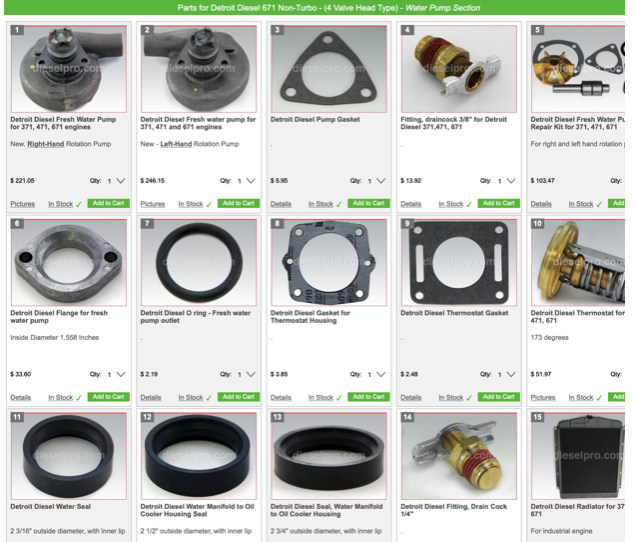
- Raw Water Pump Section
The raw water pump for Detroit Diesel engines is a crucial component responsible for drawing in seawater or freshwater and circulating it through the engine’s cooling system. It operates using a mechanical design, pulling water from external sources such as rivers, lakes, or the ocean. The pump’s impeller generates the necessary pressure to push the water through the heat exchangers, regulating the engine’s temperature and preventing overheating. The raw water pump ensures efficient cooling and optimal engine performance, particularly in marine or industrial applications where cooling water is sourced externally.
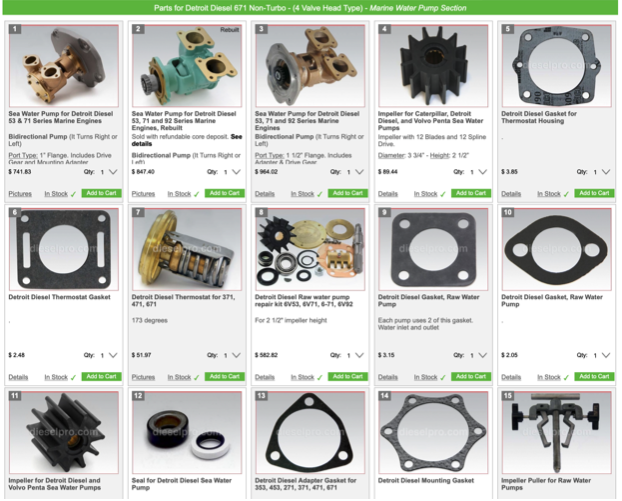
Lubrication System
The lubrication system deals with pushing oil through the engines components to lubricate them. Below is the section for the lubrication system.
Oil Pump Section
The oil pump for Detroit Diesel engines is a critical component responsible for circulating oil throughout the engine’s lubrication system. It operates using a mechanical design, typically driven by the engine’s crankshaft. The pump draws oil from the oil pan and pressurizes it, sending it through oil passages to lubricate vital engine components, such as bearings, pistons, and camshafts. This ensures proper lubrication, reduces friction, and helps dissipate heat, promoting engine longevity and efficient performance. The oil pump plays a vital role in maintaining engine reliability and preventing excessive wear and damage.
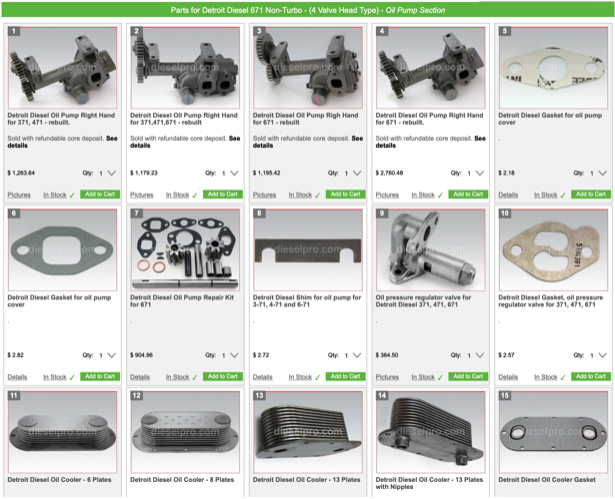
Electrical System
The electrical system of a Detroit Diesel Engine includes the starter and the alternator.
The alternator for Detroit Diesel engines is an essential component that generates electrical power to charge the battery and provide electricity to various electrical systems. Driven by the engine’s crankshaft, it converts mechanical energy into electrical energy through electromagnetic induction. The alternator ensures a reliable and continuous power supply, supporting the engine’s electrical needs and enabling the operation of essential functions such as lighting, ignition, and electronics.
The starter for Detroit Diesel engines is a vital component that initiates the engine’s combustion process by cranking the engine to start. It uses an electric motor driven by the vehicle’s battery, engaging with the flywheel or flexplate to rotate the engine’s crankshaft. The starter provides the initial mechanical force required for the engine to begin running independently, ensuring reliable and efficient engine startup.
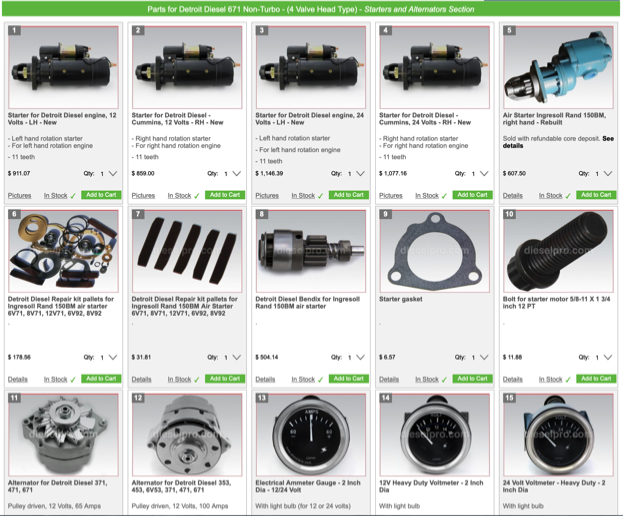
3. Maintenance and Inspection
Routine maintenance practices for a Detroit Diesel 2-stroke engine include:
- Regularly checking and changing the engine oil according to the manufacturer’s recommendations.
- Inspecting and replacing fuel filters to ensure clean fuel reaches the engine.
- Cleaning or replacing the air filters to maintain proper air flow and combustion efficiency.
- Regularly inspecting and adjusting the engine’s cooling system, including coolant levels and radiator condition.
- Checking and adjusting the engine’s belts and pulleys for proper tension and wear.
- Inspecting and cleaning the fuel injectors to ensure proper fuel atomization and combustion.
- Checking and adjusting the engine’s valve lash and injector timing as per the manufacturer’s specifications.
- Periodically inspecting and cleaning the turbocharger or supercharger, if equipped.
- Inspecting and replacing worn or damaged gaskets and seals to prevent leaks.
- Regularly inspecting and maintaining the electrical system, including the battery, alternator, and starter.
The maintenance schedule for a Detroit Diesel 2-stroke engine typically includes regular intervals for oil changes, filter replacements, and inspections, which may vary based on engine model, usage, and operating conditions. It is crucial to consult the manufacturer’s guidelines and recommended maintenance schedule for specific maintenance requirements.
4. Troubleshooting and Diagnostics For Detroit Diesel
| PROBLEM | POSSIBLE REASON | CHECK |
| Engine will not start | Lack of air intake or restricted air intake | √ |
| Broken blower shaft | ||
| Worn out blower shaft | ||
| Defective fuel pump | ||
| Defective starter | ||
| Discharged battery | ||
| High exhaust back pressure | ||
| Black smoke coming out of engine |
Defective injector |
|
| Contaminated fuel | ||
| Broken or worn cylinder parts | ||
| Engine overloaded | ||
| Faulty intercooler or aftercooler (for turbo engines only) | ||
| White smoke coming out of engine |
Broken piston ring |
|
| Incorrectly installed ring set | ||
| Defective injector | ||
| Fuel quality or grade | ||
| Long idle periods | ||
| Broken or bent push rod | ||
| Injector or governor improperly adjusted | ||
| Low engine oil pressure |
Water in engine oil pan |
|
| Fuel in engine oil pan | ||
| Defective oil cooler | ||
| Engine overloaded | ||
| Crankcase overfilled | ||
| Low engine RPM |
Improperly working injector |
|
| Governor calibration | ||
| Hi engine RPM | Governor calibration | |
| Engine overheating |
Defective fresh water pump |
|
| Defective raw water pump (marine engines only) | ||
| Defective thermostat or thermostat seal | ||
| Clogged radiator or heat exchanger (marine engine only) | ||
| Grey smoke coming out of engine |
Long idle periods |
|
| Defective intercooler or aftercooler (for turbo engine only) | ||
| Restricted air intake | ||
| Defective injector | ||
| Contaminated fuel | ||
| Blower or turbocharger seals leaking | ||
| Geartrain makes noises |
Low oil level |
|
| Engine driven accesories | ||
| Damage main or rod bearing |



 Free US Calls: 1-888-433-4735
Free US Calls: 1-888-433-4735 International: 305-545-5588
International: 305-545-5588